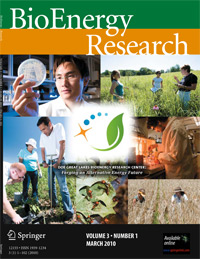
MADISON – The March issue of BioEnergy Research exclusively focuses on the U.S. Department of Energy-funded Great Lakes Bioenergy Research Center (GLBRC) and bioenergy research topics ranging from arthropods to cell walls to hydrogen and enzyme improvement.
This is the second of three special issues featuring work from the energy department’s Bioenergy Research Centers.
“This issue provides a snapshot of the diverse range of cutting-edge research within Great Lakes Bioenergy,” says Tim Donohue, GLBRC director and University of Wisconsin-Madison professor of bacteriology. “Readers curious about the latest advances in cellulosic biofuels research will certainly find something that piques their interest.”
The 11 journal articles showcase scientific collaborations at UW-Madison and Michigan State University in four broad research themes: improved biofuels feedstocks, improved conversion into advanced biofuels, sustainable biofuels landscapes, and improved cellulosic biomass processing. Open access to the March issue is available at http://ow.ly/1apjA.
Improved biofuels feedstocks: Committed to improving plant biomass for conversion to liquid fuels, Great Lakes Bioenergy researchers are working to increase energy-rich hydrocarbons in plant tissues and to create plant cell walls that are more easily broken down into their component sugars. Papers contributed by UW-Madison researchers Natalia de Leon, Michael Casler and Chris Schwartz provide a glimpse into the center’s attempts to capitalize on natural genetic mutations to create more suitable feedstocks and methods for deconstructing plant hydrocarbons into liquid fuels.
Improved conversion into advanced biofuels: Scientists are using a variety of natural genetic and genomic approaches to identify organisms and biological systems with unique properties that could increase the efficiency of converting biomass into biofuels. A research group led by UW-Madison engineer Dan Noguera is using a genetic mutant of Rhodobacter sphaeroides to study electron partitioning from nutrients into hydrogen gas.
Sustainable biofuels landscapes: One of the center’s core research areas focuses on the ensuring biological diversity across the agricultural landscape used for bioenergy feedstock production. MSU entomologist Doug Landis’ research group examines abundance and diversity of beneficial insects, including bees, beetles, and flies, in relation to species-richness of cellulosic biofuel crops, while a paper led by MSU microbial ecologist Ederson Jesus examines the mix of bacterial life that lies within the soil.
Improved cellulosic biomass processing: Developing efficient and economical biomass processing technologies will require significant improvements in the properties and combinations of enzymes used to convert plant biomass into liquid fuels. In a review, MSU researcher Goutami Banerjee and his team describe many of the current impediments to bioconversion and the Center’s approaches that include bioprospecting for superior key enzymes, protein engineering and high-level expression in plants. MSU scientist Dahai Gao reports research results of the combination of different enzymes, or enzyme cocktails, and their effect on bioconversion of maize stover.
Finally, the issue highlights high-throughput technology made possible by the center’s enabling technologies group. MSU researcher Nick Santoro describes a robotic platform that provides key measurements that allow researchers to rapidly characterize thousands of plant samples for important traits and bioconversion efficiencies.
About Great Lakes Bioenergy:
The Great Lakes Bioenergy Research Center (GLBRC) is one of three U.S. Department of Energy (DOE) Bioenergy Research Centers funded to make transformational breakthroughs that will form the foundation of new cellulosic biofuels technology. The Center is led by the University of Wisconsin-Madison, with Michigan State University as the major partner. Additional scientific partners are DOE National Laboratories, other universities and a biotechnology company. For more information, visit http://www.glbrc.org.
About BioEnergy Research:
BioEnergy Research fills a void in the rapidly growing area of feedstock biology research related to biomass, biofuels, and bioenergy. The journal publishes a wide range of articles, including peer-reviewed scientific research, reviews, perspectives and commentary, industry news, and government policy updates. Its coverage brings together a uniquely broad combination of disciplines with a common focus on feedstock biology and science, related to biomass, biofeedstock, and bioenergy production. Open access to this issue is available at: http://ow.ly/1apjA